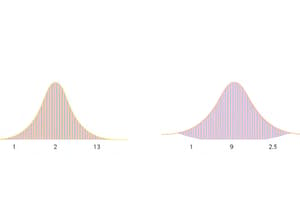Podcast
Questions and Answers
Define independent and dependent variables with examples.
Define independent and dependent variables with examples.
Independent variables are causes or predictors (e.g., type of drink), while dependent variables are effects or outcomes (e.g., sperm mortality rate).
Which of the following is a characteristic of a categorical variable?
Which of the following is a characteristic of a categorical variable?
- Numerical values measured on a scale
- Interval or ratio scale
- Distinct groups (correct)
- Continuous values
Which of these is a type of data distribution?
Which of these is a type of data distribution?
- Normal distribution
- Skewed distribution
- Exponential distribution
- All of the above (correct)
The null hypothesis assumes an effect or relationship exists.
The null hypothesis assumes an effect or relationship exists.
Explain the difference between populations and samples.
Explain the difference between populations and samples.
Define variance and standard deviation and explain their relationship.
Define variance and standard deviation and explain their relationship.
What is kurtosis, and what does it indicate in a dataset?
What is kurtosis, and what does it indicate in a dataset?
When should non-parametric tests be used instead of parametric tests?
When should non-parametric tests be used instead of parametric tests?
What is the purpose of the Shapiro-Wilk test?
What is the purpose of the Shapiro-Wilk test?
How do interaction effects differ from main effects in factorial ANOVA?
How do interaction effects differ from main effects in factorial ANOVA?
Why is data visualization important?
Why is data visualization important?
How can you avoid overplotting in scatterplots?
How can you avoid overplotting in scatterplots?
Which of these is a key assumption of parametric tests?
Which of these is a key assumption of parametric tests?
Which of these can be used to visually check the normality of data?
Which of these can be used to visually check the normality of data?
What does Levene's test assess?
What does Levene's test assess?
What should you do if assumptions are violated?
What should you do if assumptions are violated?
What is sphericity, and in which tests is it relevant?
What is sphericity, and in which tests is it relevant?
What does a correlation coefficient of 0 indicate?
What does a correlation coefficient of 0 indicate?
Correlation implies causation.
Correlation implies causation.
What is the main purpose of regression analysis?
What is the main purpose of regression analysis?
Flashcards
Independent Variable
Independent Variable
The variable that is changed or manipulated in an experiment, often thought of as the 'cause' or 'predictor'.
Dependent Variable
Dependent Variable
The variable that is measured or observed in response to changes in the independent variable, often thought of as the 'effect' or 'outcome'.
Categorical Variable
Categorical Variable
Data with distinct categories or groups that cannot be ordered, such as gender or eye color.
Continuous Variable
Continuous Variable
Signup and view all the flashcards
Normal Distribution
Normal Distribution
Signup and view all the flashcards
Skewed Distribution
Skewed Distribution
Signup and view all the flashcards
Null Hypothesis (H0)
Null Hypothesis (H0)
Signup and view all the flashcards
Alternative Hypothesis (H1)
Alternative Hypothesis (H1)
Signup and view all the flashcards
Population
Population
Signup and view all the flashcards
Sample
Sample
Signup and view all the flashcards
Variance
Variance
Signup and view all the flashcards
Standard Deviation
Standard Deviation
Signup and view all the flashcards
R-squared
R-squared
Signup and view all the flashcards
Kurtosis
Kurtosis
Signup and view all the flashcards
Non-parametric Tests
Non-parametric Tests
Signup and view all the flashcards
Shapiro-Wilk Test
Shapiro-Wilk Test
Signup and view all the flashcards
Main Effect
Main Effect
Signup and view all the flashcards
Interaction Effect
Interaction Effect
Signup and view all the flashcards
Analysis of Variance (ANOVA)
Analysis of Variance (ANOVA)
Signup and view all the flashcards
Effect Size
Effect Size
Signup and view all the flashcards
Levene's Test
Levene's Test
Signup and view all the flashcards
Pearson Correlation Coefficient
Pearson Correlation Coefficient
Signup and view all the flashcards
Regression Analysis
Regression Analysis
Signup and view all the flashcards
Logistic Regression
Logistic Regression
Signup and view all the flashcards
T-test
T-test
Signup and view all the flashcards
One-way ANOVA
One-way ANOVA
Signup and view all the flashcards
Analysis of Covariance (ANCOVA)
Analysis of Covariance (ANCOVA)
Signup and view all the flashcards
Covariate
Covariate
Signup and view all the flashcards
Study Notes
Statistical Concepts Summary
- Variables: Independent variables are the cause or predictor, while dependent variables are the effect or outcome. Examples: Type of drink (independent) and sperm mortality rate (dependent).
- Categorical vs. Continuous: Categorical variables represent distinct groups (e.g., binary, nominal), while continuous variables have measurable numerical values on a scale (e.g., interval, ratio).
- Data Distributions:
- Normal distribution: Symmetrical, bell-shaped curve.
- Skewed distribution: Asymmetrical, positive or negative skew.
- Exponential distribution: Elapsed time between successive events, independent of previous occurrences.
- Hypotheses: The null hypothesis (H0) states no effect or relationship, while the alternative hypothesis (H1) posits an effect or relationship.
- Population vs. Sample: A population is the entire group of interest, while a sample is a subset used for study.
- Variance and Standard Deviation: Variance is the average squared deviation from the mean. Standard deviation is the square root of variance, expressed in the same units as the data.
- R-squared: Represents the proportion of variance in the dependent variable explained by predictor variables in a statistical model.
- Kurtosis: Measures the tailedness (pointiness) of a distribution. High kurtosis indicates heavy tails or outliers, low kurtosis light tails.
- Non-Parametric Tests: Used when assumptions of parametric tests (e.g., normality, equal variances) are not met. Appropriate for ordinal, ranked, or non-interval data.
- Shapiro-Wilk Test: Used to test for normality in a dataset. A p-value < 0.05 signifies non-normality.
- Interaction vs. Main Effects (ANOVA): Main effects measure the independent influence of each factor. Interaction effects show how one factor's effect depends on another factor.
- Data Visualization: Effective visualization (e.g., using scatterplots, histograms) helps reveal patterns, trends, and outliers in data.
- Overplotting Prevention: Techniques to address overplotting in scatterplots include transparency, jitter, or smaller point sizes.
- Correlation vs. Causation: Correlation does not imply causation; a third variable may be responsible for the observed relationship.
- Regression Analysis: Predicting outcomes using one or more predictor variables. Simple linear regression formula: Y = a + bx, where 'Y' is the outcome, 'X' is the predictor, 'b' is the slope, and 'a' is the intercept.
- Regression Assumptions: Linearity, independence of residuals, and normality of residuals.
- Logistic Regression: Used to predict a categorical outcome, such as a binary outcome (e.g., yes/no). Doesn't meet linear assumptions.
- Odds and Odds Ratios (Logistic Regression): Odds are the ratio of event probability to non-event probability. Odds ratios show how odds change with a predictor variable change.
- McFadden's R^2 (Logistic Regression): Measures model fit and goodness of fit.
- T-tests: Used to compare means between two groups. Independent t-tests compare unrelated groups, while dependent t-tests compare related groups (e.g., pre-test vs. post-test).
- Cohen's d: Measures the effect size, indicating the magnitude of the difference between two means.
- Levene's Test: Assesses homogeneity of variances in t-tests.
- ANOVA: Compares means across more than two groups. The F-ratio (between-group variance/within-group variance) is the key statistic.
- Post Hoc Tests: Used following a significant ANOVA result to determine which specific groups differ significantly.
- ANCOVA: Combines ANOVA and regression to compare group means while controlling for the influence of covariates.
- Covariate: A variable influencing the dependent variable but not the primary focus.
- Sphericity: Equal variances for differences between all pairs of conditions (Relevant in repeated-measures ANOVA). Tested using Mauchly's test.
- Sphericity Corrections: Greenhouse-Geisser or Huynh-Feldt corrections adjust the degrees of freedom for tests involving repeated measures.
- Carryover Effects: Mitigated by randomizing condition order or using counterbalancing.
- Mixed Designs: Combine both between-subjects and within-subjects factors.
- Non-Parametric Alternatives: Nonparametric methods (e.g., Mann-Whitney U, Wilcoxon signed-rank, Kruskal-Wallis) used when assumptions of parametric tests are not met.
- MANOVA: Simultaneously compares groups across multiple dependent variables. Reduces Type I error risk and accounts for correlations between variables.
- MANOVA Assumptions: Multivariate normality, homogeneity of variance-covariance matrices (Box's M test), independence.
- MANOVA Test Statistics: Wilks' Lambda and Pillai's Trace are common MANOVA test statistics. ICC measures variance attributable to group differences.
- Exploratory Factor Analysis (EFA): Identifies underlying latent factors explaining patterns of correlations among observed variables.
- Categorical Data Types: Nominal data (categories without order), ordinal data (categories with ordered levels).
- Chi-square Test: Tests for relationships between two categorical variables, assuming expected cell frequencies of at least 5. Fisher's exact test for smaller samples.
- Cramer's V: Measures strength of association between categorical variables, ranging from 0 to 1.
- Multilevel Linear Models: Analyze hierarchical/nested data structures, distinguishing between fixed and random effects.
- Intraclass Correlation Coefficient (ICC): Measures variance explained by group membership in multilevel models.
- Random Effects (MLM): allow intercepts or slopes to vary across groups.
- Assumptions (MLM): Normality, independence across groups but not within, linearity, homoscedasticity.
- Validity/Reliability: Validity (accuracy), Reliability (consistency); Accuracy = closeness to true value, Precision = reproducibility under identical conditions.
- Types of Errors: Type I (false positive) and Type II (false negative).
- Tukey's HSD Test: Used after ANOVA to determine which specific group means differ significantly.
Studying That Suits You
Use AI to generate personalized quizzes and flashcards to suit your learning preferences.




